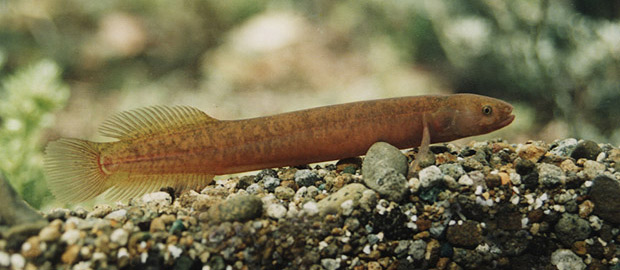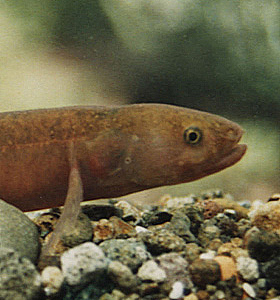| |
2012 New Zealand Threat Classification System
Black mudfish
Neochanna diversus
Gradual decline
Brown mudfish
Neochanna apoda
Gradual decline
Canterbury mudfish
Neochanna burrowsius
Nationally endangered
Chatham mudfish
Neochanna rekohua
Range restricted
Northland mudfish
Neochanna heleios
Nationally endangered
2010 IUCN Red List of Threatened Species
Black mudfish
Neochanna diversus
Data deficient
Brown mudfish
Neochanna apoda
Vulnerable
Canterbury mudfish
Neochanna burrowsius
Vulnerable
Chatham mudfish
Neochanna rekohua
Vulnerable
|
|
|
| |
 |
| |
Home > New Zealand ecology > Native galaxiid fish > Brown mudfish |
| |
| |
NEW ZEALAND ECOLOGY |
|
| |
|
|
|
|
NATIVE GALAXIID FISH |
|
| |
|
| |
| |
The brown mudfish Neochanna apoda belongs to the Galaxiidae family of the Osmeriformes order. It was the first of New Zealand's five endemic mudfish identified by Gunther in 1867.
There is just one other species in the Neochanna genus, the Tasmanian mudfish N. cleaveri, which is in small, fragmented, remnant populations in Victoria and southeastern Australia, and as its' name suggests in Tasmania.
Mudfishes were probably at one time New Zealand's most abundant freshwater fish, but unfortunately, conversion of 90 percent of native wetlands to pasture since the mid-19th century has limited them to a few scattered habitats.
Early settlers became familiar with mudfish when digging up vegetables, and farmers sometimes find them when digging drains, but they are not well known because reclusive, nocturnal habits make them hard to find. |
| |
 |
| |
Mudfishes are New Zealand's most specialised freshwater fish. They can aestivate for up to two months, surviving in damp ground during periods of seasonal drought. |
| |
 |
| |
All five New Zealand Neochanna species are specialised inhabitants of swamps, drains and forest ponds which sometimes dry up.
The distribution of brown mudfish is limited to the West Coast, in the southern part of the North Island on the Taranaki coast from Opunake south, and from Pahiatua south to Wellington. It is also found from Karamea to Okarito on the west coast of the South Island.
Brown mudfish Neochanna apoda is listed in 'gradual decline' in the 2005 New Zealand Threat Classification System, and as 'vulnerable' on the 2010 IUCN Red List of Threatened Species due to a population decline of more than 30 percent during the last ten years.
Habitat suitability is hard to assess for brown mudfish as they are now found in the widest range of habitat types of all the NZ Neochanna species. A lowland swamp fish species, brown mudfish are historically found in forested wetland areas, such as kahikatea Dacrycarpus dacrydioides swamp forest [Petrove, 2009].
Unlike both the northern species, brown mudfish tolerate a wide range of habitats from the peaty pakihi bogs of the West Coast, to eutrophic raupo swamps, swampy lake margins, forest pools, and even spring-fed swampy streams [Ling 2001]
Brown mudfish are not often found with other fish and are considered poor competitors (O’Brien and Dunn, 2007). They are preyed upon by larger native fish, giant kokopu Galaxias argenteus, and shortfin eel Anguilla australis, and introduced brown trout Salmo trutta.
Strangely, adult brown mudfish prey on their own juveniles. This is partly remedied by juveniles feeding during the day when the nocturnal adults are hiding. |
| |
 |
| |
References
Department of Conservation, New Zealand mudfish (Neochanna spp.) recovery plan 2003–13.
Ling, N., New Zealand mudfishes: a guide, 2001, Department of Conservation, University of Waikato.
Petrove, N.K., Habitat preferences of brown mudfish (Neochanna apoda Günther), a thesis in partial fulfilment for the degree of Master of Science in Conservation Biology, Massey University, 2009. |
| |
|
 |
| |
Above: The streamlined brown mudfish Neochanna apoda, which may grow up to 17 cm in length.
Photo Copyright © Stephen Moore.
 See more on native galaxiid fish See more on native galaxiid fish |
| |
 |
| |
Brown mudfish survival during drought through aestivation .....
The brown mudfish is the largest, and more elongated of the five Neochanna species - growing to a maximum length of 17 cm and living up to seven years. They are very clever, highly adaptable, uniquely evolved little animals.
Mudfishes are New Zealand's most specialised freshwater fish. They can aestivate for weeks, and even up to two months, surviving in damp ground during periods of seasonal drought.
All mudfish species are quite happy living in water year round, but they are able to subsist out of water when wetlands, peat lakes, and drainage ditches dry up in summer. |
| |
 |
| |
Brown mudfish Neochanna apoda
Photo Copyright © Stephen Moore |
 |
| |
They keep moist by burrowing into mud, leaf litter and plant debris, or under tree roots, which is made easier with strong bones in their head.
Not many fish are able to survive for any extended period out of water. But mudfish have this unusual ability to occupy places that normal fish cannot, sometimes giving them an exclusive habitat, safe from predation by bigger fish.
Of course normal oxygen intake in water through gills does not work very well during aestivation. But this is no problem - mudfish can also breath out of water through their mouth. Oxygen intake can also occur through the mudfish's skin.
When rain returns and wetlands and ponds refill, the mudfish are immediately ready to go as soon as they get back into the water. Autumn and winter is then a period of growth for young mudfish that hatched during the previous spring.
All mudfish species sexually mature during aestivation in the dry summer months, and are ready to spawn when ponds refill. The offspring are thus given enough time to grow to a length of 7 cm before they go into the aestivation period of the next summer.
Brown mudfish, black mudfish and Northland mudfish do not have a pelvic fin. This would get in the way when they leave the water to wriggle across dry land and burrow into mud. Their slim, elongated, eel-like, streamlined body is helpful for movement in shallow water and over dry land, and for aestivation.
During aestivation, mudfish slow down their heart rate and metabolism, in a similar way to hibernating bears.
As with other galaxiid fish, their thick, leather-like skin has no scales, and is coated in a slimey mucus, keeping them moist out of water and providing protection from infection. |
| |
 |
| |
|
|
The ancient Gondwana ancestry of galaxiid fish
New Zealand's freshwater fish fauna is sparse with 41 native species in nine families, but unique with the predominance of 24 species of Galaxias and Neochanna genera in the Galaxiidae family.
More than half of the freshwater fish fauna is diadromous, moving between fresh and salt water during their life.
The five Galaxias whitebait species, shortjaw kokopu, giant kokopu, banded kokopu, inanga and koaro are amphidromous, a form of diadromy relating to breeding in freshwater and larvae developing in the ocean.
The five New Zealand Neochanna mudfish Galaxiids have abandoned the sea and spend their entire lifecycle in freshwater [Ling 2001]. The Tasmanian mudfish Neochanna cleaveri, is however, amphidromous.
Only two of New Zealand's 24 Galaxiid species are not endemic. Inanga Galaxias maculatus is wide-spread throughout the southern oceans in Tasmania, southeastern and southwestern Australia, South America, and some Pacific Islands. Koaro G. brevipinnis and Neochanna cleaveri are found in southeastern Australia and Tasmania.
This is the first indication of galaxiid Gondwanan ancestry. The question remains, whether the distribution of galaxiids around the Southern Pacific ocean was by dispersal following the breakup of the Gondwana continent, and the separation of the Zealandia continent 80 million years ago; or by vicariance within Gondwana through Antarctica before separation.
Dispersal is the migration of an ancestral population across a pre-formed barrier, such as an ocean.
Vicariance is the separation of a population by a barrier, which isolates a new population, and in many cases is the initiation of speciation and the evolution of new species.
| |
 |
| |
The linked continents of South America, Antarctica, Australia and New Zealand were an overland dispersal route 130 to 35 million years ago. |
| |
 |
| |
Evidence of a vicariant origin of the New Zealand freshwater fauna is provided by a relationship between Galaxiid fish and tiny parasitic larva of the freshwater mussel, genus Hyridella, called a glochidium.
The larva attach to the fish's gills to obtain nutrients and get a free ride. The minute larval would be washed away in the current without an attachment to the fish.
By coincidence, the mussel family Hyriidae occurs in New Zealand, South America and eastern Australia in the same habitat with galaxiid fishes.
Dispersal of larva to coincide with the galaxiid fish, and evolution of the same relationship on different continents, would have been a phenomenon that is hard to imagine. It is easier to accept vicariant separation of populations, when the larva and fish were associated before Gondwana broke up.
An ancient ancestry, Gondwana origin, and vicariant origin of New Zealand freshwater fauna further revolves around the only two species of freshwater crayfish Paranephrops planifrons and P. zealandicus. Crayfish relatives in the Parastacidae family in Australia (yabby), and South America are thought to be of Gondwanan origin.
Another convincing coincidence is the relationship between flatworms of the genus Temnocephala that attach to the front claws of koura. They only live on a host.
Temnocephala have the same relationship with freshwater crayfish in Australia, and other relatives attach themselves to various hosts, including snails, crayfish and turtles in Brazil, Chile, Argentina, Uruguay, Indonesia and New Guinea.
|
| |
 |
|

